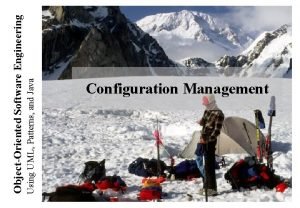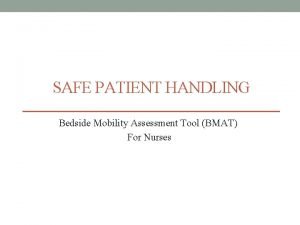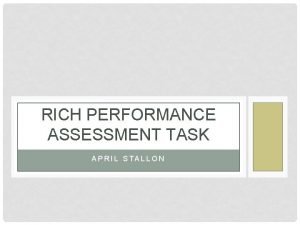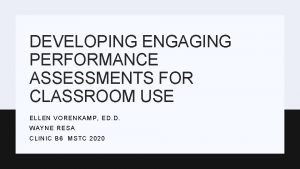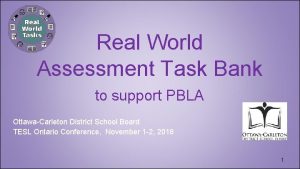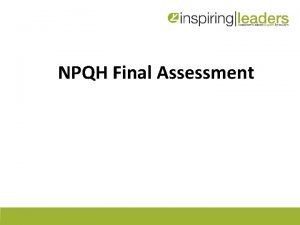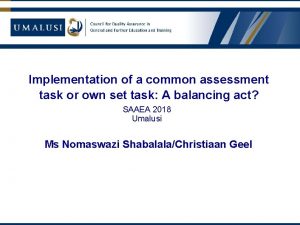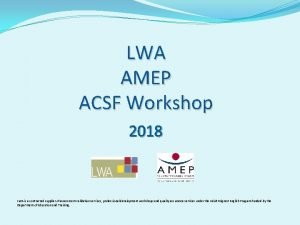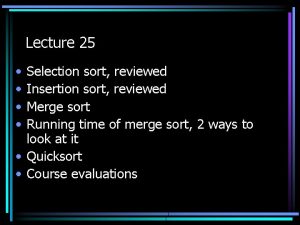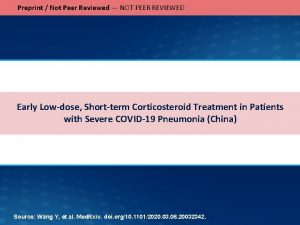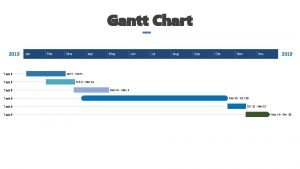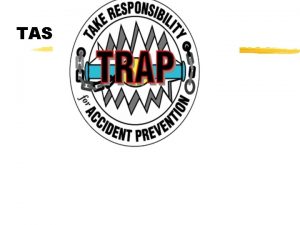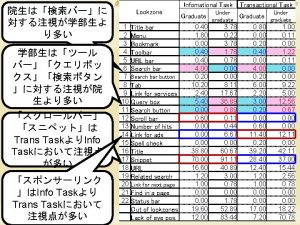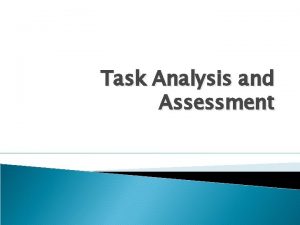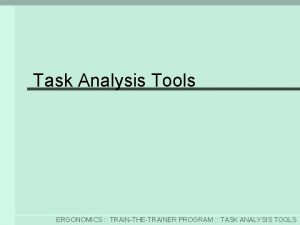Task 6 Assessment Tools Assessment tools reviewed National
















- Slides: 16

Task 6: Assessment Tools

Assessment tools reviewed • National Tools • inter. RAI • Supports Intensity Scale (SIS) • Inventory for Client and Agency Planning (ICAP) • Tools Developed by Other States • Minnesota – Mn. CHOICES • Washington State – Comprehensive Assessment Reporting Evaluation (CARE)

inter. RAI • Suite of tools developed for LTSS populations • Valid, high inter-rater reliability • Research-informed support tools in each tool • 15 scales used to evaluate clinical status including ADL Hierarchy Scale, Cognitive Performance Scale • Clinical Assessment Protocols/Collaborative Action Plans • Quality Indicators • Resource Allocation – case mix classification

Summary of inter. RAI Tools Assessment Name Population States Tools inter. RAI-Home Care (HC) Older adults/physically disabled CA, UT, SD, KS, IA, MO, CAPs, acuity scales, case AR, LA, MS, GA, IL, IN, OH, mix/resource allocation MI, PA, CT, RI, NJ, MD, HI, TN inter. RAI-Community Health Assessment (CHA) Older adults/physically disabled NY CAPs, acuity scales, case mix/resource allocation inter. RAI-ID IDD population (adult) AR, NY CAPs, acuity scales, case mix/resource allocation inter. RAI-Ch. YIDD population (child/youth) AR, NY CAPs, acuity scales, case mix/resource allocation inter. RAI-Community Mental Health Behavioral health population (adult) AR, NY CAPs, acuity scales inter. RAI-Ch. YMH Behavioral health population (child/youth) AR, NY CAPs, acuity scales

Supports Intensity Scale (SIS) • Validated, reliable, and normed tool developed by the American Association of Intellectual and Developmental Disabilities (AIDD) • SIS-A, adults 16+; SIS-C, children 5 -16 • Focus is on the frequency and level of support rather than documenting performance deficits • Establishes acuity levels (developed by HSRI) • Requires its own proprietary software solution (SISOnline) • Training and certification of assessors by AIDD is required to use SIS • Tool in use in 22 states

Inventory for Client and Agency Planning (ICAP) • Currently in use in Alaska for the IDD population • Designed for both children and adults • Measures functional needs in adaptive (e. g. , motor, communication/ social, personal/community living) and maladaptive behaviors (e. g. , disruptive, hurting self or others) • Produces score from 0 -100, reflecting level of service intensity required • Typically used in combination with other assessment tools • In use in 11 states

State-Specific Assessment Tools • Mn. CHOICES • Development began in 2004; rollout began in 2013 and is ongoing • Designed to integrate assessment tools across multiple populations including individuals with physical disabilities, IDD, children, behavioral health • Based on the inter. RAI-HC • Comprehensive Assessment Reporting Evaluation (CARE) • • Developed in early 2000 s; 3 years to build the tool Built off the inter. RAI-HC Includes 14 acuity groups with resource allocation/case mix SIS integrated into assessment process for IDD population

Summary Matrix of Assessment Tool Features and Functionality

Implementation Issues • Costs of assessment implementation • Assessment tool costs • inter. RAI – Royalty-free license to states for use of the tools • SIS – License fee ($175/assessment) and per-assessment fees ($19/assessment) • IT/Software costs • Varies substantially from state to state • SISOnline is software solution for SIS • Several authorized inter. RAI vendors (including Medi. Ware – AK IT vendor) • Training costs • Unknown for inter. RAI • SIS training - $7, 500 for initial training, additional follow up training costs as well

Approach to Review of State Experiences • Only 4 states have adopted both (i) and (k) • California, Maryland, Montana, and Oregon • From December 2015 to February 2016, HMA reviewed (i) and (k) SPAs for each state of these 4 states and interviewed staff in each state • Goal was to understand how each state is meeting the requirements of (i) and (k), implementation issues, successes/challenges, best practices, and lessons learned

California • 1915(i) – effective 10/2009 • Target population: IDD population under 18 years who require habilitation services, no institutional level of care • Covers population <150% of FPL; provides services to medically needy but does not waive requirements re: spousal income • 1915(k) – effective 12/2011 • First state to get (k) approved; built off existing personal care benefit • Optional benefits covered • Transition costs • Services substituting for human assistance: restaurant meal allowance • CA did not convert any 1915(c) waiver benefits to CFC

Maryland • 1915(i) – effective 10/2014 • Target population: Children or youth with serious emotional disturbance • State is covering the optional categorically needy eligibility group with incomes <150% of FPL, or who are eligible for 1915(c) waiver with incomes not exceeding 300% of SSI rate • 1915(k) – effective 1/2014 • Optional benefits covered: • Transition costs • Services substituting for human assistance: home delivered meals, environmental assessments, technology • Concurrent with CFC implementation, Maryland merged two 1915(c) waivers to cover services not permissible under CFC

Montana • 1915(i) – effective 1/2013 • Target population: Children/youths age 5 -17 with serious emotional disturbance; youth up to 20 years who are still in secondary school may opt in • Projected enrollment: 56 in Year 1 • Covers population <150% of FPL; provides services to medically needy but does not waive requirements re: spousal income • 1915(k) – effective 10/2013 • Montana did not elect to cover the optional CFC services • Retained existing 1915(c) waivers to cover services not required and not permissible under CFC

Oregon • 1915(i) – effective 1/2012 • Target population: Individuals with chronic mental illness • Covers population with Medicaid <150% of FPL; does not extend benefit to medically needy • 1915(k) – effective 7/2013 • Optional benefits covered • Transition costs • Services substituting for human assistance: environmental modifications, assistive devides, community transportation to gain access to Medicaid services, activities, and resources, and home-delivered meals • Oregon maximized CFC by shifting most of its State Plan PAS and 1915(c) waiver services into CFC; very little was retained in the waivers

Key Themes: Planning • Eligibility • Need a solid understanding of eligibility criteria, both financial as well as functional/diagnostic • Oregon noted that CMS has been hammering on the sufficiency requirement; even if the program expands beyond what the state estimated, it cannot be rolled back. • Services • Approach to development of the service array for 1915(k) was similar for CA, MD, and OR: take as much of their existing programs as CMS would permit and move them into CFC in order to maximize the federal match • MT initially sought approval for those services required under CFC and chose not to opt for permissible services • CA, OR, and MT all recommend taking a minimalist approach

Key Themes: Planning (cont’d) • Fiscal Impact • States generally acknowledged that there are still significant costs associated with 1915(k), even in light of the FMAP enhancement • CA and MD both indicated that had they pursued a budget neutral proposal, they would not have been able to implement necessary changes to comply with federal requirements • Development and Implementation Council • Varying levels of engagement with their Councils • All continued to engage their Council during implementation period; most continue to engage them now although on a less-frequent basis
 Foo9822
Foo9822 Goutresolved reviewed
Goutresolved reviewed Tiered task bias task
Tiered task bias task National core standards south africa
National core standards south africa Bmat assessment tool
Bmat assessment tool Icass practical assessment task 2 2017 memorandum
Icass practical assessment task 2 2017 memorandum Magda van pletzen
Magda van pletzen Rich performance assessment task
Rich performance assessment task Product-oriented assessment
Product-oriented assessment Types of performance task assessment
Types of performance task assessment Egd practical assessment task 2020
Egd practical assessment task 2020 Writing assessment year 4
Writing assessment year 4 Real world tasks
Real world tasks Curriculum-led budget template npqh
Curriculum-led budget template npqh Common assessment task
Common assessment task Curriculum-led budget template npqh
Curriculum-led budget template npqh Lwa assessment task bank
Lwa assessment task bank
